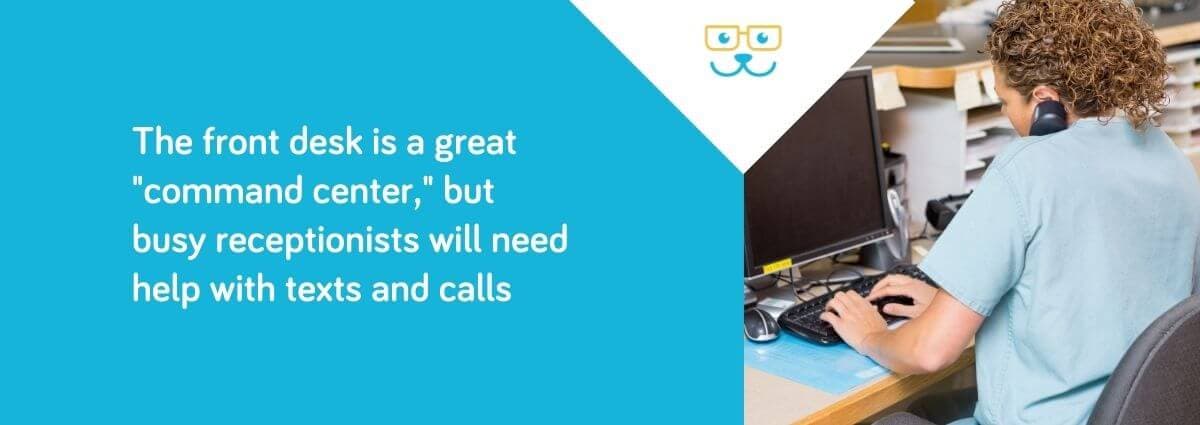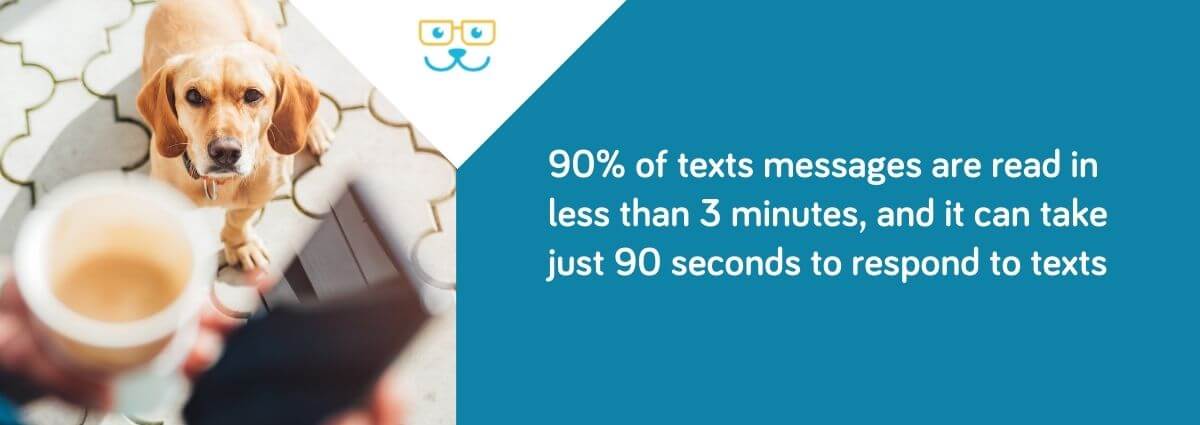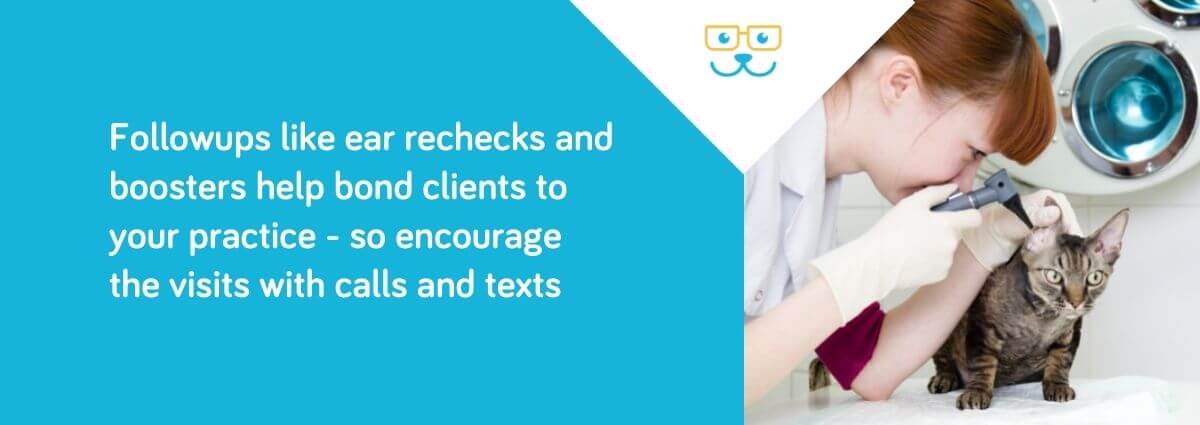Veterinary Client Retention Is Just A Text Away
Phone calls and texts are widely-used to confirm veterinary appointments and are widely valued by pet owners who appreciate the helpful reminders. But these methods of communication can only do so much more for patient health and client retention. Service and follow-up appointment messages belong in the realm of smartphones; after all, 97% of Americans use text messaging, and over 180 billion (yes, that's with a 'B') are sent every month! So if your practice implements a system to contact pet owners on their cell phones with patient progress and recheck messages, you have a great chance of reaching nearly every one of your existing clients to retain them.
A Smartphone is Smart for Business
Every practice needs to have a phone and/or text system, and some of the systems that practices pay for are very helpful with that. But in addition, every practice needs to personalize or enhance that with its own procedures. For instance, if you rely on a pre-packaged setup, which itself relies on your receptionists simply remembering to implement it, your calls and texts will fall through the cracks. This is normal because the front desk can frequently become incredibly busy, so your team will need to identify how to best get these crucial calls and texts accomplished.
As a specific example, at The Drake Center for Veterinary Care, the staff could use a third-party system to send text reminders. However, clients would receive those texts from that third-party provider on behalf of The Drake Center instead of from The Drake Center itself. But even text messages can come with a more personal touch: send them from a practice-dedicated cell phone number. You’ll be able to use this phone for photos, video, and social media, and you can use it for after-hours critical care contact. And because this phone is officially connected to the practice, if you use it for text messaging, those texts will come directly from your practice to your clients.
Don’t Rely Solely on Receptionists
Naturally, receptionists will most often make phone calls and send texts because they have the “command center” setup of the front desk. Furthermore, check-in and follow-up client contact can be fit in between other tasks, one at a time, on an as-needed basis. But technicians have a role, too. They’ll need to make the follow-up lab work calls, for instance. Additionally, there are some instances, such as after major surgeries, when a doctor will need to reach out. And overall, the doctors will set the medical standard for which patients need what type of contact and when.

The doctors will need to clearly communicate and document these standards for the staff to reference. Then, with the Practice Manager, they’ll devise a system of accountability. Note that “accountability” does not mean “punishment.” Instead, this means “tracking.” Your practice management software may be able to help, or you might design tracking of your own. Consider a log or “to-do” list that is accessible to anyone responsible for the task. They can initial and/or check off when each call or text is complete as they log the calls. You may have treatment codes that automatically trigger a follow-up communication task. You might have intra-office communication that doctors use to assign calls and texts to specific staff members.
The Practice Manager should consistently monitor the assignments, logs, or lists to ensure follow-through and find the tactics that work best for your practice's size, staff, and culture. Understand that this system is in place to help you retain your clients and remind them that they should continue to schedule appointments with you. So, with each call or text that notifies clients about the best health care for their pets, you’ll also be protecting the health of your business.
Why Focus on Smartphones?
Veterinary recommendations need to be exact, and they need to be followed precisely, so why wouldn’t email or post mail be the best method of contact for every scenario? Note that texts and phone calls are ideal for appointment reminders - clients have set these appointments themselves, so they already have the needed background information. This is the same reason that they work well for follow-up contact for:
- Overdue services that you would have alerted clients to already before they were due
- Illness, injury, or short-term condition followups that make up a series of visits established by the doctor at the time of initial diagnosis
- Long-term chronic condition care that doctors will help clients understand at the time of diagnosis
Because people prefer contact on cell phones, mainly through text, having a phone call and text message system down pat is vital for retaining your veterinary client base.
Phone calls are fantastic for personalized communication. If you speak directly to your client instead of their voicemail, you have an immediate two-way conversation, allowing for clear and concise answers to questions.
Text messages are sent, read, and replied to much more quickly than emails, which means improved daily efficiency for your staff members. In fact, Patterson Veterinary reports that 90% of texts are read in less than 3 minutes, and it can take just about 90 seconds to respond to a text. Combine that with the fact that nearly a third of consumers prefer and would recommend your business if you communicate via text, and you have a simple way to deliver the type of customer service that local pet owners are looking for - and will motivate them to return to your practice.

Phone Calls or Texts for Overdue Veterinary Services
When a patient’s veterinary services are overdue, you’ll want to work on retention for both the health of your business and the health of that pet. And despite your best efforts to forward book and/or remind pet owners before those services are due, there are times when appointments aren’t scheduled before those due dates. These situations need an integrated approach. You may have sent postcards and emails ahead of due dates, and you likely repeated these as the services became overdue. But, particularly at the 60-day or more past-due point, it’s time to add in phone calls and texts.
Up to this point, the postcards and emails have not been enough to spur the appointment, for whatever reason. And whether the client has forgotten, has gotten too busy, or even has moved, switching up your contact method will give you a better chance of gaining renewed attention. It’s important to remember your intentions: your goal is not to harass your clients into submission but to help them balance their busy lives with their pets’ health care needs. In terms of record-keeping, you’ll need to know if a client has moved out of your service area, plus ensure that they have medical records to maintain continuity of care at a practice in their new community. Of course, in terms of pet health, you want to ensure that each of your patients is current on protective, preventive services with a physical exam.
Following Up for Followups
Many conditions will resolve in the relatively short term, and they require follow-up care on different levels. Think of:
- Vaccine boosters
- Incision rechecks
- Ear rechecks
- Dental cleanings recommended after a wellness exam
Each of these instances will require a follow-up visit and perhaps even a series of visits until they are resolved, and the patient can return to standard preventive care or chronic illness reminders. These visits may bring in additional revenue, or the series of visits may be all-inclusive with the initial exam fee. Either way, they’re all part of client bonding and retention: they bring clients and patients back to your office for continued care.

Additionally, these are all instances that may need nudges from you to remind clients to schedule. Texts can be perfect here since there is not a lot of background to explain; these are the sorts of follow-up appointments that your clients should be expecting, based on your recommendations at the initial visit. Save the postcards and emails to complement your efforts to explain a bigger picture, long-term preventive schedule, or chronic illness management. If short-term appointment series were not forward-booked, send a simple text to encourage appointment setup.
Calling (or Texting) All Chronic Conditions
While consistent follow-up for chronic conditions is vital, it can quickly become tedious for clients to remember just the right combination and timing of exams, lab work, and medication refills. As with short-term conditions, the doctors will determine the timing and service needs for pets with chronic diseases and help pet owners understand, for example, why:
- Diabetic pets need lab work every three months
- Obese patients need monthly weigh-ins
- Cardiac patients need recurring exams
Certain clients will fall into a routine based on reminder texts combined with mailings, yet often phone calls are the most beneficial for serious, chronic illnesses. These clients spend a great deal of time, energy, and money at your practice, and the personal touch of a phone call lets them know that your staff wants to check in for the benefit of their pets. It reinforces their bond with your practice and allows them to ask and answer all of the questions that inevitably come with disease management.
Client retention depends on pet owners remembering the importance and timing of their pets’ specific veterinary care needs. While many of them will diligently keep track of these, nearly all of your clients will appreciate hearing from your practice, both to remind them of these needs and to understand your commitment to caring and simply checking in! The most convenient method for your staff and your clients is via phone calls and text messages.
To learn more about attracting clients, hiring and retaining high-quality employees, and improving your profitability, schedule a GeniusVets Demo!

